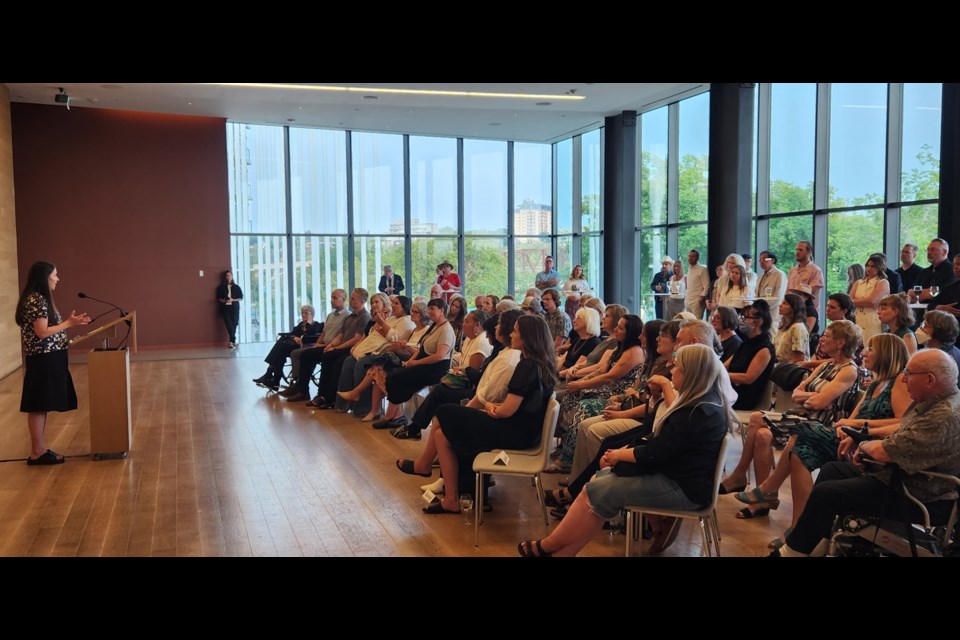SASKATOON — Meryl McMaster, a highly acclaimed photographer of Plains Cree descent from the Red Pheasant Cree Nation, has captivated art enthusiasts with her visually stunning self-portraits.
It typically takes her around three years to meticulously craft her artworks, combining extensive research with a creative approach that resonates with thousands of admirers attending her exhibitions.
In her latest exhibition, Meryl McMaster: bloodline, she masterfully weaves traces of her grandmother's life through evocative photos and shared stories. The show recently opened at Remai Modern and will grace the gallery until Dec. 31, with plans to be displayed in Quebec.
“My work has spanned over 15 years now. It takes me around two to three years to complete a body of work. From research, thinking about how to execute it to the creation showing the different elements in the photographs,” McMaster told SASKTODAY.ca.
Drawing inspiration from the vast prairies surrounding her, McMaster infuses her works with elements deeply cherished by First Nations Peoples, such as earth, fire, water, and wind. These elements hold immense significance for her, symbolizing the enduring connection between humanity and nature, particularly in Indigenous communities.
Having grown up in an urban environment where the sky often remains obscured by towering buildings, McMaster finds solace and inspiration in the uninterrupted expanse of the prairies. Her ancestral ties to the Red Pheasant Cree Nation further reinforce her affinity for capturing movement and fluidity in her photographs, represented through intricately designed costumes adorned with feathers and ribbons that sway with the wind.
“The prairies and parts of the [Treaty] territories are something I always recognize. Being born and raised in a city where buildings block our view of the sky, I come to the prairies to visit the sky and where my family came from,” said McMaster.
“I am from Red Pheasant Cree Nation and the view of the sky in the prairies is uninterrupted. That is present in many of my images. I try to show movement in the costumes, whether having little feathers or ribbons that move in the wind and other elements of nature.”
Moreover, McMaster takes great pride in her mixed ancestry, which combines Indigenous heritage with that of European settlers who explored and inhabited the land. Through her art, she delves into her personal history, culture, and lineage, all while exploring broader historical events that have shaped her identity and the world around her.
“That is a connecting factor from my past. My ancestors [Indigenous and European] came in to explore this land. I am photographing and using the land in different ways. Exploring my mixed ancestry that makes me who I am,” added McMaster.
“I am looking at my history, culture and lineage in the land. It is something that I'm passionate about and researching broader kinds of historical events and not just my experiences and questions.”
Resourcefulness and creativity are at the heart of McMaster's artistic process. She crafts her elaborate costumes and props from readily available materials, often transforming seemingly ordinary objects like wires and cardboard into breathtaking works of art. Her dedication to sustainability and innovation shines through as she repurposes used sports helmets, decorating them with feathers and ribbons to enhance their aesthetic appeal.
“I have worked with other trades, like a welder, in the past. I worked with a seamstress, sometimes to help me create a garment. But, for the most part, I build using readily available materials like wires and cardboard. I even used a used sport helmet that I decorated with feathers, ribbons and other materials that I gathered. I start from scratch and work with materials that might be lying around the house. I did not have much money when I started, so you have to make do with what you have,” she said.
Remai Modern's Curator of Indigenous Art, Tara Hogue, expresses excellent admiration for McMaster's contributions to the art world. Even before Hogue's position was established in 2020, the museum showcased and collected works by Indigenous artists, including McMaster and her powerful self-portraits.
This acquisition of McMaster's works allows the museum to continue sharing vital narratives about Treaty 6 Territory, celebrating its rich history and profound impact on Indigenous communities.
“So, I'm always working on new plans to develop exhibitions that feature Indigenous artists from here and elsewhere. The museum’s first acquisition of her works will allow us to continue telling important stories about this territory for generations,” said Hogue.
“The exhibit features her older works but ‘Stories of My Grandmother’ is the series name. That is a story that is rooted in this place. Red Pheasant is just two hours northwest of [Saskatoon]. That is an important part of history the museum wants to represent.”
The exhibition features a series entitled Stories of My Grandmother, deeply rooted in Red Pheasant, located merely two hours northwest of Saskatoon. This focus on the region's history aligns with the museum's commitment to representing and preserving its significant cultural heritage.
Meryl McMaster's captivating artistry reflects her Indigenous ancestry and is a powerful reminder of the enduring connection between humanity and nature. Through her lens, she captures the essence of her heritage and weaves a tapestry of stories that resonate with audiences far and wide.




